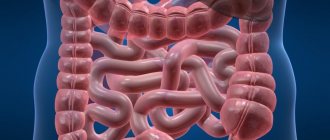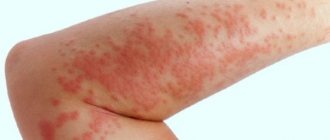Reading time: 7 minutes
The baby's development is just beginning in the womb. After its birth, it adapts to external factors, including new nutrition. Greenish stool in a breastfed baby is an alarming symptom that you should definitely pay attention to.
What should a normal stool look like: age matters
- In the first few days after birth (up to approximately one month of age), original feces (meconium) are passed. It can be thick, with mucus, and have a greenish tint.
- After the child gets used to life outside the mother’s body, the digestive organs begin to form feces differently. In children of one month of age, its consistency becomes mushy, the color approaches a greenish-yellow hue.
- Over time, the color of stool becomes yellow. There are differences in feces between breastfed and formula-fed children. Breast milk is more easily absorbed by the body and processed faster. The color of stool is light brown or yellowish.
The frequency of stool during breastfeeding can be from one to several times a day. Even if stool does not pass within a few days, there is no need to worry too much. But this is only if the child is cheerful, active and nothing bothers him.
The absence of feces for up to four days indicates good processing of breast milk by the intestines.
With the introduction of complementary foods, stool becomes rare - up to once every two days. Color and consistency will depend on the staple food. For example, foods such as broccoli and pear give stool a green color.
In what cases is green stool considered normal in weakened children?
When using some breast milk substitutes, for example, hypoallergenic formulas, the baby will normally have gray-green stools. Since these mixtures come with partial (hypoallergenic - HA) or complete (for example, Alfare) hydrolysis (splitting) of cow's milk protein, during the digestion of such a product, the baby's feces become dirty green.
The technology of partial hydrolysis of cow's milk protein is used in the production of formulas for the prevention of allergic diseases in children of the first year of life. Therapeutic mixtures for children with allergies to cow protein are produced on the basis of complete hydrolysis of milk protein.
Also, when introducing complementary foods to a bottle-fed baby, the digestive tract may react in such a way that the baby’s stool becomes a completely different color than it was before. The color may also change to green.
If nothing bothers the child (no temperature, no impurities in the stool - mucus, blood, no change in the baby’s well-being), then there is no reason to worry. Some time after the introduction of new foods, the baby’s digestion will improve.
Iron-fortified formulas also change the color of the stool to a greenish color. The reason for this is the interaction of iron with oxygen contained in the air, that is, its oxidation.
Mixed-fed babies eat both mother's milk and formula. For this reason, they may have green stools even more often, since all the problems described above may be relevant for them.
What determines the change in stool color?
Green stool in an infant may indicate illness, but not always.
The reasons for the color change may be as follows.
- In a newborn, bilirubin may be excreted in the stool, which gives it a green color.
- The child's body is influenced by the mother's hormones.
- The newborn’s digestive system is not fully formed, which sometimes results in a lack of enzymes for breaking down food. In this case, the stool may contain mucus.
- If you do not change the diaper on time, the feces can oxidize under the influence of oxygen and acquire shades of green.
- When breastfeeding, the mother's nutrition plays a role. Perhaps she ate foods that could affect the color of stool - pear, cabbage, cucumber, zucchini.
- Taking medications containing iron.
- There is not enough breast milk, resulting in the baby not receiving enough enzymes that help break down milk sugars and fats.
- Lack of lactose in milk.
If there are streaks of blood in your child's stool, you should seek help from a specialist. In addition, there may be liquid stool with mucus and a strong odor. In this case, the reasons are much more serious.
- Dysbacteriosis. The child is bothered by bloating, colic, and skin rashes may appear. In breastfed children, disruption of intestinal flora can occur even if the mother additionally drinks boiled water. Loose stools appear, often with mucus.
- Bacterial infections.
- Diseases caused by a virus that affects the proper functioning of the intestines, and stool changes its color to green.
- Intestinal infections: fever, vomiting, abdominal pain.
- After taking antibiotics. The stool becomes green in color. May be slimy in nature.
- Allergies are a common cause.
- Pathologies of the digestive organs. This type of violation requires surgical intervention.
- Colonization of the body by parasites (helminths, worms).
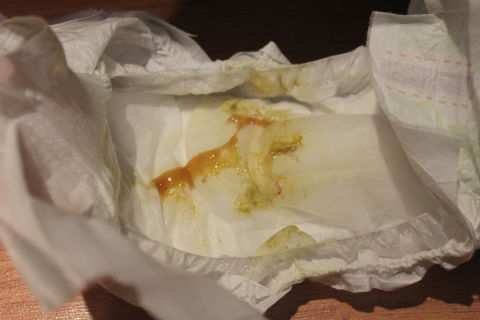
Possible reasons for changes
Green stool is not always a cause for alarm.
Possible sources of unnatural color of stool in a small child include:
- the beginning of complementary feeding - bright vegetables, greens and fruits can cause a similar reaction;
- changes in the mother’s diet and, as a result, in the composition of breast milk;
- weakening of the immune system;
- age-related changes in the body;
- reaction to taking medications;
- food allergies;
- intoxication of the mother’s body as a result of poisoning;
- insufficient lactation;
- dysbacteriosis;
- inflammation in the gastrointestinal tract due to difficult childbirth;
- baby's lactose intolerance;
- colonization of parasites;
- onset of intestinal infection;
- disturbances in the functioning of the endocrine system.
One of the most common causes of such disorders is insufficient lactase production .
Lactase is an enzyme produced in the small intestine, necessary for the proper breakdown of the carbohydrate lactose.
In case of its deficiency, due to the work of local flora in the large intestine, a fermentation effect occurs. Gases are formed intensively.
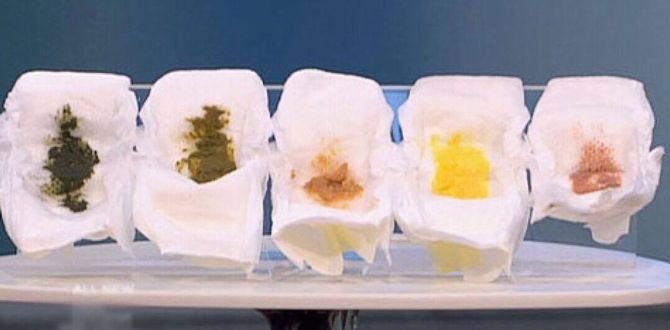
The feces change color and begin to foam. In addition to severe bloating, increased fatigue, nervousness of the child, and sleep disturbances may be noted.
Lactase deficiency can be primary or transient. The latter type is most often found in premature babies. This is caused by late maturation of enzymatic mechanisms and disappears after 3 months.
Expert opinion
Ignatieva Elena Leonidovna
Lactation consultant
The stool may take on an unusual color as a result of oxidation under the influence of oxygen. Therefore, changing a diaper at the wrong time can frighten parents without a serious reason.
Eating infant formula is a serious burden in itself. With a mixed diet, greenish stool may occur in a newborn for the following reasons:
- increased dose of iron in the artificial mixture;
- incorrectly selected nutritional proportions;
- immunity failures as a result of difficulties with the gastrointestinal tract;
- eruption of the first teeth;
- a consequence of a cold;
- allergic reaction to store-bought mixture.
How to recognize the disease
- Green stool with mucus may appear. The main reasons are dysbacteriosis and colds.
- Green stools with foam, which can occur due to a lack of enzymes and poor nutrition. Rarely, the main cause of such stool is staphylococcus, medication, allergic manifestations and intestinal infection.
- Dark green stool is a consequence of changes in the fat content of breast milk. The newborn’s body reacts very sensitively to all changes in nutrition. Sometimes this may be due to the fact that the baby is receiving milk from the anterior chamber of the breast. It contains only lactose and serves as a drink for the child. The food is milk from the posterior chamber - it is rich in fats.
In addition to changes in the color and consistency of stool, the condition of the newborn worsens:
- the child sleeps poorly, becomes restless, constantly asks to be held;

- abdominal pain and colic, and when the tummy is lightly touched, the child begins to be capricious;
- lethargy and apathy appear;
- poor appetite;
- nausea, vomiting, frequent regurgitation may occur after feeding;
- increased body temperature;
- frequent loose stools, which can lead to dehydration.
The main cause of green stool
But still, the appearance of this color of stool may indicate a digestive disorder. The most common cause of green stool during breastfeeding is improper feeding management. Therefore, the mother needs to take measures, and not give medicine to the child.
Breast milk consists of two parts: “front” and “hind”. Foremilk is thinner and easier for the baby to suck out. But it's low in nutrients and doesn't fill you well. Hind milk is more nutritious and fatty. It contains the hormone lactase, which breaks down milk sugar. But many babies, especially in the first weeks after birth, do not have the strength to suck it. When feeding, they only receive “fore milk” and then abandon the breast.
Because of this, the mother thinks that the milk in the breast has run out and gives the baby a second breast, from where he again sucks only the “front” milk. It turns out that the baby does not receive the necessary nutrients and is not satisfied. This may cause his stool color to change, becoming green or greenish. Doctors often call it “hungry.”
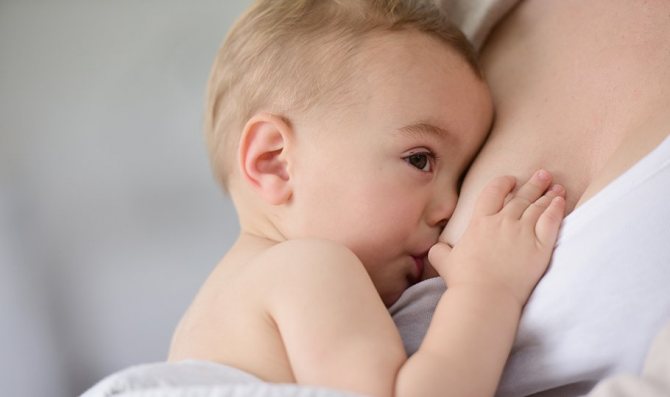
If breastfeeding is not organized correctly, the baby may not have enough strength to suck the most valuable “hind” milk
Green stool may appear when the mother's diet changes. This could be a sudden change in diet, including a large amount of vegetables and fruits. This reaction is especially often caused by zucchini, broccoli, dill and cucumbers, excess sugar in food, whole milk or consumption of foods with a large number of preservatives and dyes. If a woman takes certain medications, for example, iron supplements or antibiotics, hormonal imbalances can also affect the color of the baby's stool.
Greens can appear in the diaper when there is excessive release of bilirubin in feces or when there is an insufficient amount of enzymes and bacteria in the baby’s digestive system. This often happens in the first weeks of a newborn's life. Green stool is often caused by oxidation in air. If the diaper sits for a while, its contents will turn green.
Digestion and color of stool in a child are disrupted even with the early introduction of complementary foods. It is not recommended to give a baby additional food until 4-5 months. And complementary foods are introduced gradually, one product at a time. Even giving the baby extra water or baby tea can lead to a change in the color of the stool. Doctors believe that this occurs due to dilution of gastric juice, which causes a decrease in the number of enzymes.

Sometimes green stool in a baby is a reaction to the mother’s poor diet
If a baby has green stool with foam, this also does not always indicate illness. Foam may appear when weather conditions or phases of the moon change, or when there are strong temperature changes. The mother just needs to carefully monitor the general condition of the baby and try to breastfeed the baby correctly.
Prevention of violations
The main rule is to carefully monitor the condition of the newborn.
- During the first feedings, the child’s condition is monitored. Products are administered in small portions. If after any product you experience loose stools or constipation, or other symptoms arise, you should postpone it for a certain period.

- Correctly apply to the breast, do not often change one breast to another. This is what guarantees that the baby will receive milk rich in fat.
- If there are problems with stool (it has become liquid, the color has changed), doctors advise expressing the first portion of breast milk - this way the baby will quickly receive milk from the posterior chamber.
Organization of breastfeeding
To prevent the appearance of green stools and provide the baby with the necessary nutrients, you need to properly organize breastfeeding. To do this, the expectant mother needs to visit specialists during pregnancy and study this issue.
Treatment of dysbiosis in children
There are several rules for breastfeeding:
- First of all, you need to properly place the breast in the baby's mouth. It should capture not only the nipple, but also the areola, with the nose touching the breast.
- When sucking, no air whistling should be heard, and the mother should not feel pain.
- Breastfeeding should be done at the baby's request. There is no need to feed by the hour. The baby should suckle as much as he wants; the breast should not be taken away from him, otherwise he will not receive enough hind milk.
- For the same reason, you should not change breasts while breastfeeding. If you do this, the baby will only suck foremilk from both breasts. If the child is often attached to the breast, it is recommended to use one for 2 hours, then another for 2 hours.
- Mom needs to eat a balanced, varied diet. But you can’t change your diet suddenly. New foods should be introduced gradually and the child’s reaction should be observed.

It is very important that a woman who is breastfeeding eats properly, then the baby’s digestion will be normal
What to do?
In the event that the greenish color of feces is caused by replacing the artificial formula or by the nursing mother eating certain foods, then this problem can be eliminated quite easily.
To establish normal digestion in a baby, you must adhere to the following rules:
- Mom should exclude fried and smoked foods from the diet and eat foods that are healthy for the baby (vegetables, boiled meat, cottage cheese and kefir).
- When breastfeeding, make sure that the baby sucks not only fore milk, but also hind milk , which is fattier and more nutritious.
- Before using any medications, the mother should consult a doctor to ensure that they will not harm the baby.
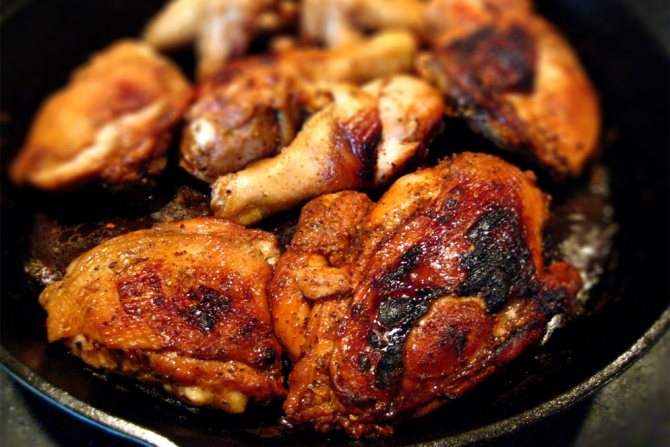
Fried foods should be excluded from the diet of a nursing mother.
If mucus, blood clots and a putrid odor appear in the newborn's stool, parents should immediately contact their pediatrician rather than wait for these symptoms to go away on their own.
What to do if the stool is green
If a newborn has green poop, what should the mother do:
- Correctly attach the baby to the breast, allow him to be fully saturated and complete the feeding process on his own;
- Follow the breastfeeding schedule on demand;
- Control your diet, avoid all additives and exotic foods;
- Treat disorders in the child’s gastrointestinal tract only under the supervision of a doctor.
Important! Green stool in combination with other unpleasant symptoms is a reason to consult a doctor.
When to sound the alarm?
Greenish stools are considered normal for newborns in the first months of their life . But only if the baby eats well, sleeps peacefully, does not cry for no apparent reason and does not show any signs of anxiety.
But, if green stool is accompanied by symptoms such as skin rashes, fever, or too frequent regurgitation , then this is a serious reason to contact a children's clinic.
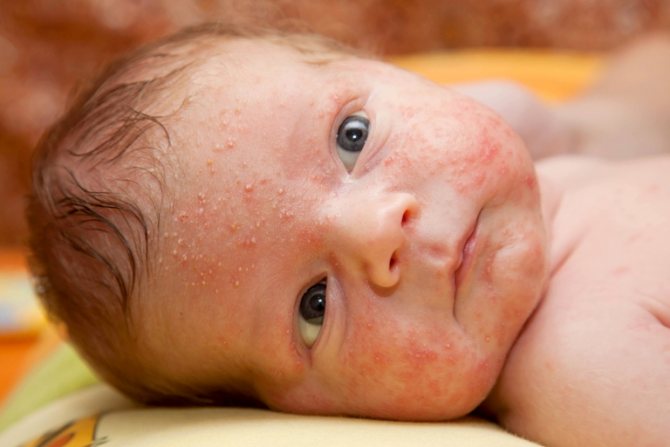
If you experience skin rashes or green stools, you should consult a doctor.
It is also worth paying attention to the consistency and smell of the stool. Very loose stools and feces with an unpleasant putrid odor may indicate dysbacteriosis and even poisoning. If you have these symptoms, you should not delay visiting a doctor.
Green poop in a bottle-fed newborn
Greenish feces in formula-fed babies can be caused by an incorrectly selected formula or a change in the manufacturer of baby food.
When choosing an artificial mixture, you should pay attention to its composition. Increased iron content in baby food is a possible cause of green coloration of newborn stool. In this case, it is enough to choose a mixture from another manufacturer.
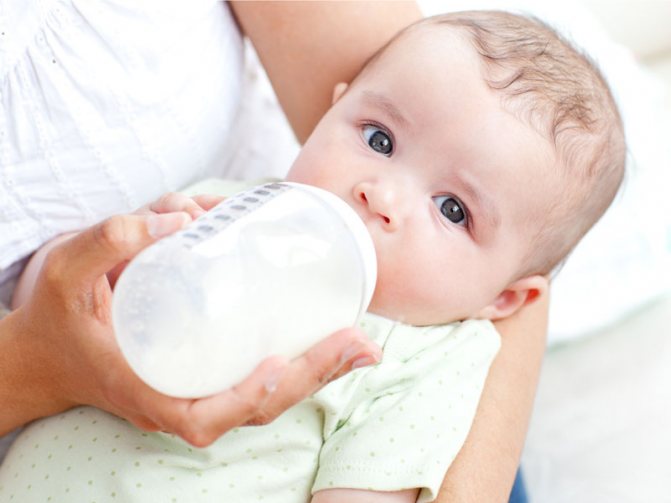
When choosing a formula for your baby, you need to study its composition in advance.
Properly selected baby food is the key to the health and full development of the baby, so this issue should be approached with all responsibility and not rely on the recommendations of friends or acquaintances.





